What is a Flat White? Demystifying This Popular Drink

What is a Flat White? Well, it's a controversial coffee beverage that has become a favorite worldwide!
Flat whites are available at coffee shops all over the world, but do you actually know what it is? And how is it different from a latte or cappuccino?
A flat white is a coffee drink made with espresso, steamed milk, and a thin layer of microfoam.
Let’s examine the history of the drink, how to make one, and what makes it such a controversial beverage in the coffee industry.
The Origin of the Flat White
While the history of this drink is contested, it originated in either Australia or New Zealand.
One story gives credit to a man by the name of Fraser McInnes, a barista in Wellington, New Zealand. Legend has it that in 1989, Fraser attempted to use low-fat milk to make a cappuccino. That milk didn’t foam correctly and remained flat, but he decided to keep it on the menu anyway.
He called this new drink a “flat white” coffee.
Another possible creator of the flat white is Alan Preston, the owner of a café in Sydney, Australia, in the 1980s. He claims to have coined the term in 1985 and is very intent on making sure the world knows Australia invented the drink, not New Zealand.
Alan even created a website dedicated to counting the history of flat white coffee. (1) There, he provides a picture of his coffee shop taken in 1988 with “flat white” written on the menu in the back (second board from the left and second on the list after cappuccino). It’s hard to see, but Alan claims this as proof he invented the drink.
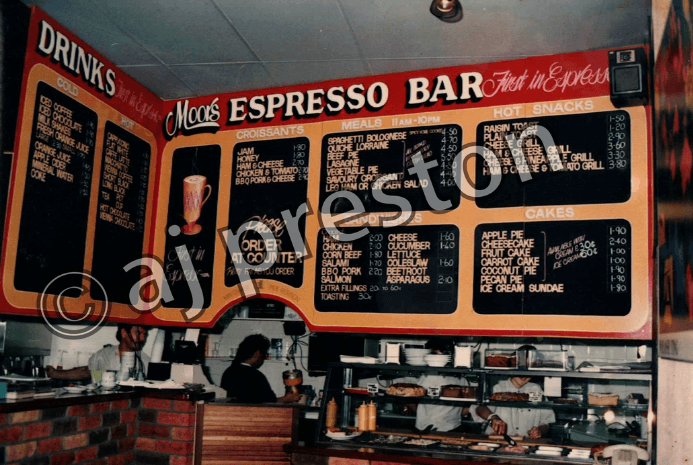
“One thing is guaranteed, I did it before the Kiwis. It seems to me that if I said I invented the Flat White in 1969, then the Kiwis would say they did it in 1968.”
Either way, the flat white has spread across the world over the past few decades. You can find variations of this drink throughout North America, Asia, and Europe.
What is a Flat White, Exactly?

Flat white is a type of coffee that is espresso-based and made with a small amount of steamed milk and a thin layer of microfoam.
While it seems that every coffee shop has its own take on flat white coffee, it was traditionally made using two shots of espresso.
Flavor and texture are key to the drink and perfect for someone who wants to appreciate the complex flavors of specialty coffee, but who also wants something milk-based. The 4 oz of milk steamed into a velvety thin texture lets you taste the rich flavors of the espresso without the milk taking over.
The milk used is very creamy, and you shouldn’t be able to feel the tiny air bubbles in the steamed milk (like the foamed milk in a cappuccino).
It’s typically a smaller-sized beverage between 5-6 total ounces. Starbucks and other large chains offer a “flat white” in 10+ oz sizes, but these stray very far from tradition and drink more like lattes.
How to Make a Flat White
Before we get started, here are a few important notes:
- Ingredients: 16-18 grams of ground coffee, and 4 oz of milk.
- Equipment needed: espresso machine with a steam wand and a pitcher (we will also show you how to make this drink without an espresso machine and steamer).
- Grind size: Make sure to grind your coffee “very fine” whenever making espresso. We recommend using a burr grinder for consistent particle sizes, but you can ask your local coffee shop to grind your beans for you, too.
- Coffee roast: Start with a medium to dark roast when you first make this drink. It’s more forgiving than light roasts and won’t get masked as easily by the milk flavors.
- Milk: You want to pick milk that is lower in fat content. Plant-based milk tends to have lower fat content and doesn’t froth as quickly as whole milk. This is actually what you want for a flat white, so the milk becomes creamy rather than airy.
How to Prepare a Flat White with Steamed milk
Step 1: Pulling the espresso shots
Using an espresso machine, pull a 2 oz double espresso into a 6 oz ceramic mug.

Step 2: Steaming the milk
Pour the 4 oz of milk into the pitcher. Use your espresso machine’s steam wand to froth the milk. This step works better if both the milk and pitcher are chilled before starting.
Keep the pitcher at an angle to create a vortex in the pitcher, and slowly steam the milk until a thin layer of foam appears on top. Keep the steam wand deeper in the pitcher to create a creamier microfoam, perfect for a flat white coffee.
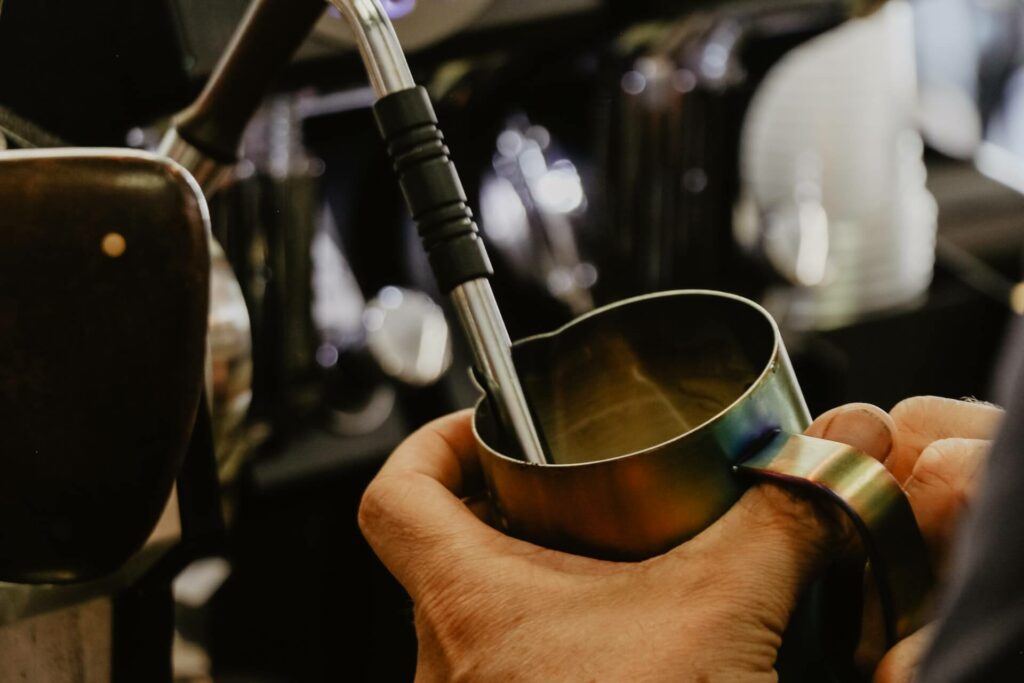
Step 3: Pouring the milk into the espresso
Pour the milk into the ceramic mug that has the espresso shots. Hold the pitcher slightly above the mug, bringing it gradually closer to the surface of the drink while pouring in the center.
Even though a flat white is technically smaller than a latte, the milk texture is pretty much the same. Channel your inner barista and try your hand at some latte art!
Now sit back, relax, and enjoy your freshly-made flat white coffee.

How to Make a Flat White at Home Without a Machine
While an espresso machine is necessary to make a traditional flat white, you can still make something similar without a machine. Since many people don’t have espresso machines in their homes, here’s a recipe to make a modified flat white using a French press, Aeropress, moka pot, or pod espresso machine.
Step 1: Making the “espresso”
We recommend making a very concentrated 2 oz of coffee to mimic a double shot of espresso. You can do this with a French press, Aeropress, or moka pot. Just make sure to increase the amount of coffee you normally use.
If you have a pod machine available, like a Nespresso by Breville or De'Longhi, make sure you select a double-espresso Nespresso pod.
Pour this “double shot” into a 6 oz ceramic mug.

Step 2: Frothing the milk
If you have a dedicated milk frother, use that to froth 4 oz of milk into a pitcher. If you don’t have a frother, you can use a French press. Simply fill the device with stovetop or microwaved warm milk and move the plunger up and down until you get a frothy texture. This may give you a quick workout!
Just make sure you clean your French press very well afterward.
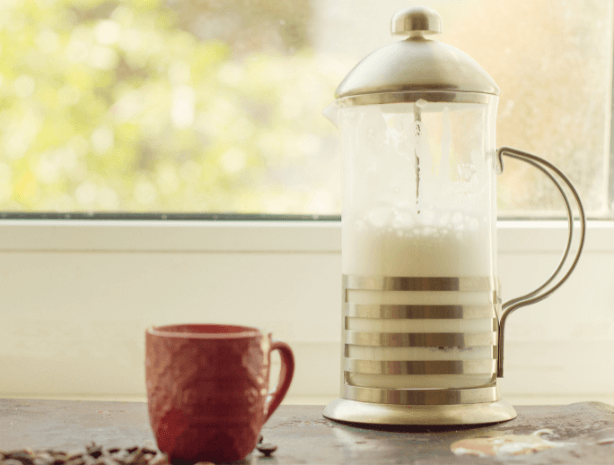
Step 3: Combining the coffee and milk
Remove the plunger from the French press and tap it gently on the table to remove any large air bubbles. Remember: you want to keep the texture as creamy as possible and not overly airy. Slowly pour the steamed milk into the ceramic mug, make a latte art design, and enjoy!
What are the Benefits of Flat White Coffee?
The same health benefits that come with consuming coffee apply to flat whites. While the healthiness of dairy vs plant-based milk, such as oat milk, is a topic for another article, the caffeine and other components from the actual coffee in this drink have various health benefits.
Consuming moderate levels of coffee may be linked to:
- Higher energy levels
- Lower risk of type 2 diabetes
- Better brain and liver health
- Decreased risk of heart failure (2)
While consuming moderate amounts of caffeine can be beneficial, there are also risks in consuming too much.
Flat White vs Latte
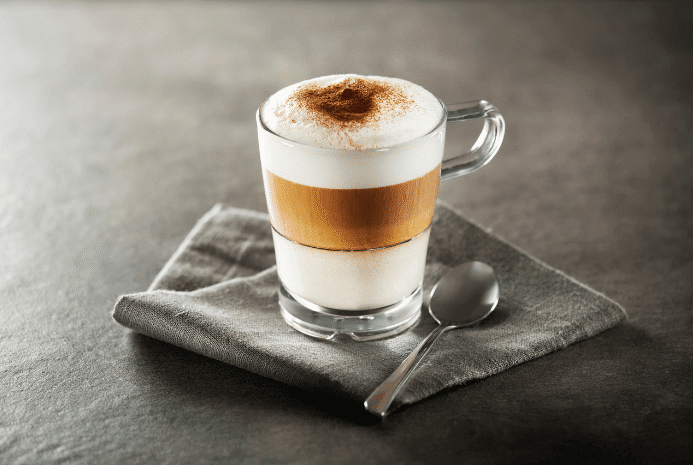
Many people confuse a flat white coffee for a latte. When coffee shops seem to serve a flat white in many different ways, it can be hard to know the differences between the two drinks… if there are any.
The first difference involves origin. While the flat white was born in Australia or New Zealand, the latte is an Italian beverage. Originally called “caffè latte”, the latte started in Italy as a very milky drink with either one or two shots of espresso. Flat whites are served with two shots.
Another big difference is size. The latte tends to be larger than a flat white, using between 6-10 oz of milk and a thicker layer of foam. The flavors of the espresso are more muted as the milk dominates the drink’s creamy taste.
a Latte also tends to be served in a tall, clear glass, while a flat white comes in a ceramic cup.
Flat White vs Cappuccino
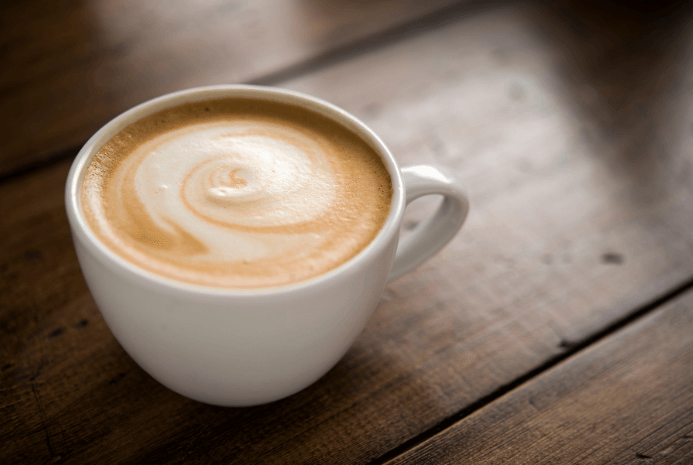
The cappuccino is very similar to a flat white coffee in a lot of ways. They often use the same amount of espresso and milk, and they come in small ceramic mugs. In fact, you can normally use a cappuccino mug to make flat whites. They are interchangeable.
The main difference between the two has to do with the texture. The foamed milk in a cappuccino is frothed more, creating a lighter and airier texture with noticeable air bubbles.
In flat whites, you steam the milk to create a richer, creamier texture. You shouldn’t be able to notice any air bubbles on your tongue when you drink the beverage.
Instead of the large foam layer that cappuccinos are famous for, flat whites have a thin layer of microfoam that sits on top of the drink.
Popular Reads:
- Different Types of Coffee Makers - Which Is Best?
- Best Coffee Maker with Grinder [Grind and Brew]
- Iced Latte vs Iced Coffee: Know All The Differences
- Spanish Latte: Let's Clarify Some Popular Claims About This Drink
Frequently Asked Questions
What’s the difference between a flat white and a latte?
Lattes are milkier and larger than flat whites. A latte uses between 6-10 oz of milk and a thicker layer of foam. The flavors of the espresso are more muted as the milk dominates the drink’s taste.
A flat white uses only 4 oz of milk to let the nuanced flavors of the espresso shine through. While the textures of the milk are similar, the coffee-to-milk ratios vary greatly.
Lattes are also normally served in tall, clear glasses, while most flat whites come in ceramic mugs. Both are great drinks to make latte art with!
What is so special about a flat white?
A flat white is a very popular drink ordered all around the world. However, each coffee shop tends to have its own spin on how to prepare this drink. It typically comes with two shots of espresso and 4 oz of creamy, velvety-textured milk with a thin layer of microfoam.
It’s the perfect choice for someone looking to experience the flavors of specialty coffee in a milk-based drink. Because of the small amount and unique texture of the milk, it doesn’t drown out the intensity of the coffee like in other milk-based beverages, such as lattes.
What is the American equivalent of a flat white?
While some may argue that a flat white is the same as a latte or cappuccino, this is wrong. If served in the traditional way, flat whites differ greatly from other milk-based beverages due to the coffee-to-milk ratio, texture of the milk, a thin layer of microfoam, and the two required shots of espresso.
Of course, each barista may have their own version of a “flat white”, and it doesn’t help that large chains like Starbucks create 10 oz or bigger sizes of a drink that is meant to be 5-6 oz in total.
Lattes and cappuccinos can come with one or two shots of espresso. Lattes use 6-10 oz of milk, whereas a flat white only uses 4 oz. Cappuccinos use an airier, more frothy milk texture than the creamy, velvety texture that comes from the steamed milk used in flat whites.
While the flat white originally came from Australia or New Zealand, many specialty coffee shops in the United States continue to serve this drink in its traditional way. It’s worth asking the barista how they prepare flat whites if you are ever unsure of what you are ordering.
Is a flat white stronger than a latte?
A flat white can be stronger than a latte in terms of caffeine if it comes with a double shot of espresso. Flat whites are traditionally served with two shots of espresso, while lattes come with either one or two.
The coffee flavor in flat whites is usually stronger than in a latte due to the coffee-to-milk ratio. Lattes use 6-10 oz of milk, while flat whites use only 4 oz. The body, flavors, and complexity of the espresso shine through more boldly in a flat white. A latte tends to mute the espresso more with its larger amount of milk.
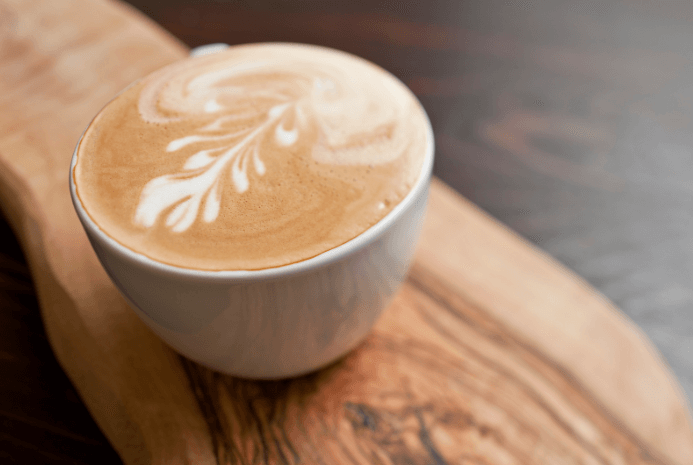
Final Thoughts
There you have it - the question "what is a flat white?" should no longer be in your books. In fact, you should be able to easily explain to someone the complete history of the flat white and how to make one.
If not, then here's a quick summary!
Flat whites have a unique mouthfeel and showcase the rich flavors of espresso, unlike other milk-based coffee drinks. It’s the perfect drink if you want to appreciate the complex flavors of specialty coffee while also enjoying a milk-based beverage.
While this drink is definitely meant to be different from other coffee drinks, each coffee shop has its own variation. Some stray into latte territory, while others make a drink strikingly similar to a cappuccino.
If you have any doubt about what you are ordering at a new coffee shop, it’s worth asking the barista how they make their flat whites. There’s no harm in asking!
This article is intended for informational purposes only. It is not meant to replace professional medical advice, treatment or diagnosis. Do not consume any type of coffee, tea or herbal infusion if you are allergic to it. The information in this article is not intended to treat serious medical conditions. Please seek professional medical advice before using home remedies.